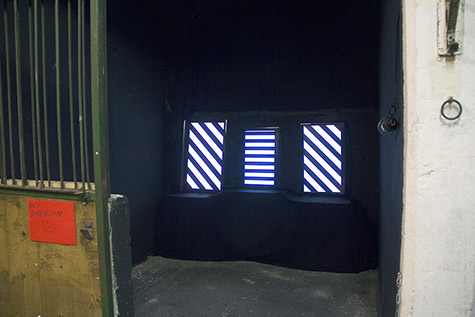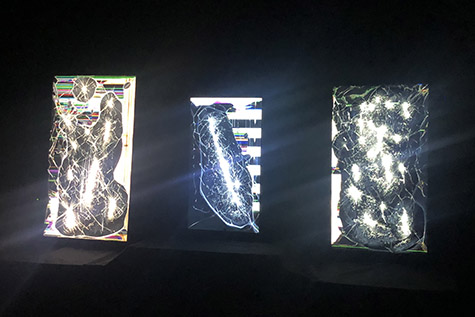I would like to start my first post, introduction aside, talking about one of the most recent events I attended: the Playground Festival AV in Vienna. AV stands for Audiovisuals, and it’s the concept of the whole festival: gathering artists from different countries and with different backgrounds to show and share their artwork, whether it’s a painting, a video, a music production, or a mix of these. The location this year is new and couldn’t have fit better to the festival: the Creau, a quiet area close to the Danube formerly used as a stable. A long dark corridor with horse boxes on both sides offers the exhibition itself, where each artist in his own box presents his ideas, having his own space to curate. Art is confined, still it mixes together, due to the numerous lights and sounds coming out from every direction.

And a great variety of styles and techniques combines in an atmosphere blinking at the future with a contemporary dark humour. Because this is the feeling, an abandoned place filled with colourful, obsessive and playful creativity. Then we can see (in a scattered order) a plastic wrap sea horse trapped in a metal cage, getting its shape only when air is pumped in with a creepy sound that reminds that of a drill (Kristoffer Stefan, Jan Lauth); five balloons in the dark with the faces of some world leaders projected on them lightened by winking lights (Andreas Muk Haider); a frame in which mirroring ourselves in a slow-motion distortion of the image (A: Nego Yokte, V: Dornwittchen); a live-painting on PVC panels using poor materials and tools that gain a different effect and colours depending on the light put in the background (Werner Ellend); and many other installations and interactive platforms. It’s fascinating to see all these different approaches, and messages, as well as the interaction of the visitors with it. This is a playground, and everyone seems to enjoy being child again.

And there’s the music. Electronic, experimental, presented as a show with djs in lab coats and a fluorescent dance choreography (Soundpharmacy) or accompanied by visuals, sometimes acid and disturbing, other times dreamy and eclectic. The Rondelle, the second area of the festival, is the perfect location for showing movies extracts and performances: rounded shaped as its name recalls, it reminds of a circus tent and offers a great space for images to be projected all around and rotate above the spectator, forced to keep the nose up as enchanting is the view. And many big matrasses lay on the floor to offer a better perspective for the eye and a more comfortable view. Here the performances from Sirio AV (first project from Dario Jurilli and Simone Andalfato), Das Stadtkind feat. Dornwittchen, and Polymer, gave a different dimension to music with the use of visuals dancing together with the beat.

In this fascinating context I got to know (or simply approached) Oli Sorenson, an artist performing during the opening day of the festival: Canadian born, artistically grown up and developed in London, with his artwork, Video Pistoletto, he literally breaks the conventions by chiselling LCD screens. At first sight his box looks similar to the others: three LCD screens hung on the wall in the dark, presenting thick black and white stripes having different orientations with respect to each other; the room is dark and empty, apart from a huge nail – a chisel – and a hammer. It’s when I am in the Rondelle that I start hearing people say “he is breaking the screens! That’s so cool!”. And, sceptic as I am (yes, me too), but curious as a cat I run inside: and what I see is just great. Short delicate but precise hammer blows break the first layer of the screen, letting the crystals mixing and giving life to new colours and shapes.


Here’s the interview he granted me, after I told him about my idea of starting a blog.
What is your background?
Wow that’s a tough question, where to start? I’m basically Canadian, but my dad travelled all the time with his work so I was born in Los Angeles. I did most of my art education in Montreal, then I moved to London in 1999, where I got my big break as a VJ, collaborating with pretty big music acts like Leftfield, Above & Beyond, M.I.A. as well as a club residency at Ministry of Sound. I was always a fan of visual arts and got my foot in the doors with exhibition projects by producing AV performances that suited evening programs in museums like Late at Tate and the AV Social nights at the British Film Institute. So I did a few of these across the UK and Europe, and got to meet a number of artists that were also doing both club visuals and art exhibitions like Quayola, Zan Lyon and Micha Klein. With their influence I convinced myself that I could make the transition from club performances to art exhibitions, and initially started with mapping works, projecting videos of 2D patterns onto 3D objects. Eventually I found that projecting really minimal patterns worked best, which resembled Daniel Buren’s art, so I called this series Mapping Buren.
How did this idea for Video Pistoletto come to your mind?
After the Mapping Buren series, I noticed how much sampling was an important process in my work. I wasn’t trying to challenge the rules of copyright, but on the other hand I became really obsessed with the overwhelming volumes of cultural content that everyone had access to, either online, in print form or elsewhere. And in a way this de-motivated me to try and produce anything new of my own. Instead I was fascinated with the idea of reviewing and amending other people’s creative output. I love the basic principles of Arte Povera for example, but I thought so much was lacking in this movement, and felt the urge to upgrade it to a twenty-first century discourse and make it relevant again. So I borrowed Michelangelo Pistoletto’s gesture of hitting mirrors with a mallet and redirected it towards Liquid Crystal Display (LCD) TV screens.
What would you like to communicate with this project?
Once I noticed how much cultural content was abundant everywhere, I realised how much Pistoletto’s solution – to create from destructive actions – was relevant to me and the highly consumer environment I was immersed in. I became aware of how much the consumption of new products, especially technological ones, were dependant on the destruction of older ones. I wanted to encapsulate this idea into an artwork. Also the premise of Arte Povera was to work with poor materials, so in this line of thought, what better material to work with than electronic goods, which are engineered with planned obsolescence to become obsolete after only a few years? By breaking the screen surfaces of aging LCD TVs, I was in part accelerating their fall into obsolescence, but ironically I was also turning them into artworks, so adding value to these objects. What’s strange about televisions in general is that, as objects, they are meant to be ignored. One rarely pays attention to the TV itself, but only to what is broadcast through electronic signals. When the TVs get broken however, this is one of the only moment when viewers really look at their TV as an object, rather than only look through it to the mediated content. To make this process more engaging, I try to break the LCD screens in very seductive ways, so that viewers become very conscious of their gaze, their act of looking at something.

What are your next projects?
I’m revisiting a film remix series I started a while ago, but now I’m applying the same method to the entire James Bond film franchise. The series is called No More Heroes, and in a nutshell, I take away every frame of the movie where I can see or hear the main protagonist, so in this case, Sean Connery, Roger Moore or any other actor that played James Bond. This way I try to point out the redundant narrative templates within mainstream cinema, and surprisingly, when I play back all the 24 films simultaneously in a huge mosaic of videos, very similar events happen in every film, involving either a sexy lady, some kind of gadget weapon, an evil henchman or an explosion. The James Bond films are surprisingly homogenous and formulaic in their storytelling. Also this process of erasing highlights the central position of Caucasian men assuming the role of heroes. Once the leading roles are removed from such films, I hope the viewers will notice that the remaining characters manifest a much greater diversity of gender, age and ethnicity. I’m screening this piece on August 17 and 18 at Art Mur gallery in Berlin. Everyone is welcome, it’s a free event!
Still, too many were the artists I would dedicate some words too… but I am also sure I will soon have the occasion for doing it!
Find more information about the festival, venue and artists on the official page of Playground AV 2018. The pictures are taken from the official Facebook page of Playground AV 2018 and from the official website of Oli Sorenson.
I liked the playground with its experimental artworks – a lot in a multimedia linked form. I am happy to see new artists overpowering the technology and opening a new view to the mainstream vision. Playful as the event here has been! Interesting and inspiring! Yes it is the inspiration that is found in artwork and the joy of playing. Deconstructing context.
LikeLiked by 1 person
Thank you for your thoughtful comment, Walter!
LikeLike
[…] a digital mirror altering colours and movement, that I already mentioned in the post about the Playground Festival; a panel with two plaster cast faces emerging out of it, one happy one sad, lightened by changing […]
LikeLike